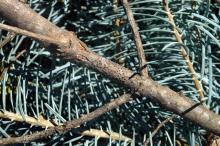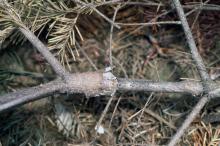Cause The fungus Grovesiella abieticola can cause a canker and dieback on true fir. The fungus is found growing primarily on lower branches and stems. Young trees are attacked most often, making this a more serious disease in nurseries and Christmas tree plantations than in natural stands. White fir and shasta fir are more susceptible than noble fir or grand fir.
The life cycle is not well understood. Mature fruiting bodies can be found any time of year, even up to a year later on dead branches removed from infected trees. Time and location of infection and the time between infection and canker development are unknown. Young needles and shoots are the most likely sites of infection. Cankers continue to expand if not removed from infected trees.
Symptoms Sunken, dead areas (cankers) develop on branches or stems older than 1 year. Generally the branch above the canker is swollen or enlarged and tapers distal to the infection. Twigs also may die back. Occasionally entire saplings are killed when the canker completely girdles the stem. Tops of larger trees may survive up to a year after being completely girdled, making early detection difficult. Small (0.5 to 1 mm in diameter) gray-black fruiting bodies (apothecia) of the fungus may be found on the canker's surface. No wood staining accompanies infection.
The disease can be confused with Phytophthora root rot or shoot blight when flagging branches are low to the ground.
Cultural control
- Cut out and destroy infected trees in Christmas tree plantations.
- Removing and immediately destroying cankered branches from infected trees in ornamental nurseries or landscapes can help. Regular scouting aids in detecting cankers early.
- Isolating susceptible species from other species may help reduce disease spread in the nursery.
Chemical control Some fungicides have been effective in limiting pathogen growth in the laboratory, but there is no evidence for effective chemical control in the field.
Reference Funk, A. 1978. A new Grovesiella on Grand fir. Canadian Journal of Botany 56:245-247.



